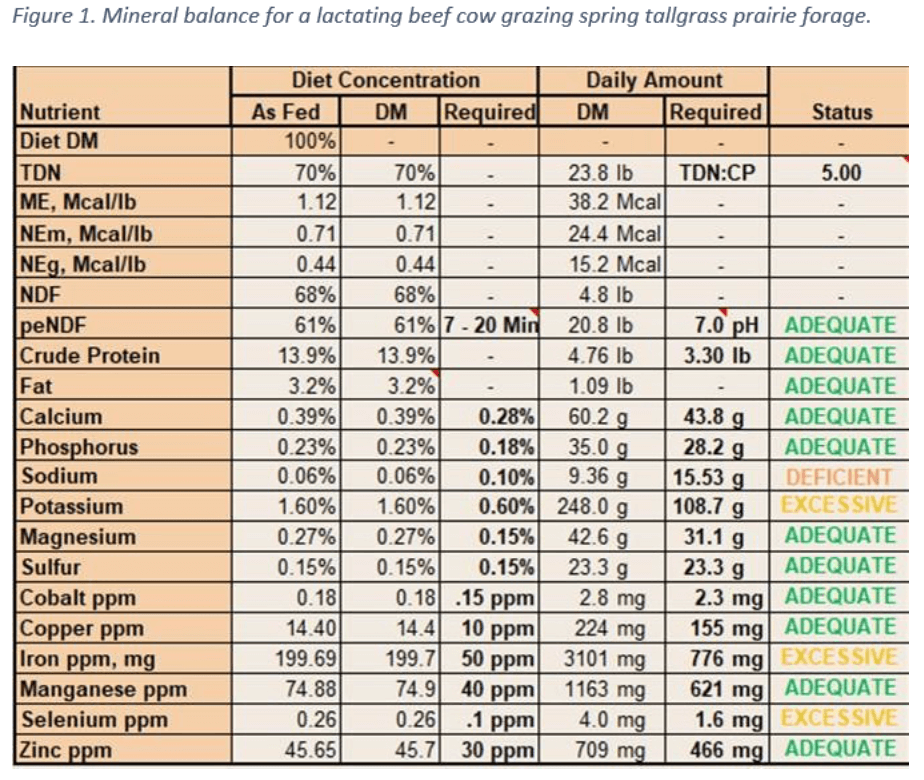David Lalman, Oklahoma State University Extension Beef Cattle Specialist
Grazing cattle generally benefit from a mineral supplementation program. Simple, right? After all, a well-balanced, cost-effective program only requires knowledge of vitamin or vitamin precursor, and mineral supply from the forage base, vitamin and mineral element digestibility and availability, and the animals’ vitamin and mineral requirements for their current age, stage of production, and mineral status (abundant vs depleted stores). Top it off with cattle’s tendency to be finicky and unpredictable in mineral supplement consumption and you have a situation that one of my friends would refer to as “a conundrum causing great annoyance and displeasure.”
Chief among the sources of uncertainty is the dynamic nature of forage vitamin/mineral supply and the cows’ requirements; moving targets. Obviously, the mineral program does not need to produce precise balance each month, which is just about impossible to achieve anyway. Nevertheless, a simple mineral balance exercise or audit should be helpful to a) give you some confidence in your current program, or b) reveal an obvious need for a change. A mineral balance excercise involves developing a simple, consistent record keeping system to track forage mineral composition and your cow herds’ average or “normal” mineral consumption pattern during the same time of year. With this information, you can use a nutrition evaluation program to project deficiencies and/or excesses. You will need an idea of forage mineral concentration, an estimate of forage intake, a current estimate of average daily mineral supplement consumption, and the mineral product’s composition from the label. Most beef cattle nutrition evaluation programs provide an estimate of forage intake and an estimate of daily mineral requirements based on the animals’ weight and stage of production.

As an example, Figure 1 shows the nutritive balance table for 1,200 pound lactating beef cows grazing lush spring tallgrass prairie forage and consuming 3.3 ounces per day of a commercial mineral supplement. You can quickly view the status incidators in the right column to determine where major gaps or excesses exist. In this examle, these cows are projected to be about 7 grams per day short of sodium. Since salt contains 40% sodium, this suggests that these cows could use an additional 15 grams of salt or about 0.5 ounce per day. There are several excesses identified in this example. Most mineral balance excercises in the Southern Great Plains are going to reveal excessive potassium and excessive iron due to high forage concentration of both minerals. The other revelation in this balance exercise the the considerable excess of selenium. Thus, the conclusion of this exercise is that a) this mineral supplement is a good complement to this forage source for this time of year and b) one could blend about 10 to 15% salt with the mineral to better match the sodium requirement with intake and c) the selenium concentration in the commercial product could be reduced by about 50% if that were an option. It most definitely points out that there is no need to purchase mineral product containing a greater concentration of selenium in this case.
Several commercial nutrition companies provide services to conduct these balance excercises and follow up by recommending or manufacturing mineral formulations customized to your operation’s needs.
In recent years, commercial livestock nutrition laboratories have incorporated mineral composition analytical services. For example, our lab at OSU charges $12 per sample to get macro and micro minerals. Depending on your level of concern or interest, one might get started by conducting a winter feeding and summer grazing balance. A more ambitious approach might be to collect “hand-plucked” samples from one or more pastures each month. The idea of the hand-plucking method is to select only plants and parts of plants that you believe to represent what your cattle are currently grazing.
Consider collecting forage mineral composition and mineral supplement consumption data several years in a row to get a clear view of your operations’ patterns over time. Using that valuable information, you can get a good idea of how well your current program or product matches your forage resource to meet your cow herd’s needs.
